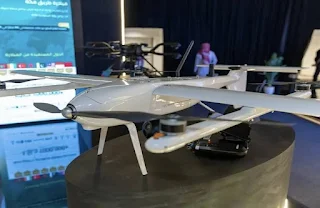For this year's Hajj season, Saudi Arabia has launched an integrated system of technologies using drones and artificial intelligence to ensure the safety and security of pilgrims.
Drones and artificial intelligence technologies have become a key component of Hajj missions, enhancing surveillance, crowd management, firefighting, road monitoring, healthcare services, and medication delivery. They also analyze the scene in real-time, identify abnormal patterns, and send immediate alerts to the operations and control center, enabling rapid response and the necessary measures to ensure the safety and security of pilgrims.
Drones are participating in this year's Hajj across several vital sectors. The Civil Defense is using the Saqr drone for firefighting purposes for the first time. This year, the Civil Defense launched the Saqr firefighting and rescue drone, featuring smart technology, advanced capabilities, and a high response speed.
The Saqr operates for 12 hours at high altitudes, with a payload of up to 40 kilograms. It utilizes a multi-purpose firefighting system, rescue, control, and safety systems, and thermal cameras with the ability to broadcast live to the site and connect to the command and control center.
The drone has multiple uses, including high-rise buildings, industrial sites, sites containing hazardous materials, crowded areas, and forest fires. It boasts high response speed, reduced risks to personnel, and support for decision-making through real-time imaging.
In the field of security and participation in preserving the security and safety of the guests of God, the advanced drones of the Public Security provide superior flying ability in the airspace and borders of the holy sites, to monitor violators of Hajj regulations within the “No Hajj Without a Permit” campaign, and to track all vehicles that sneak in and attempt to enter through unusual paths through the wilderness areas and on the mountain slopes to arrest violators, which was revealed by the security services that announced the arrest of many violators before they reached their destination after technical monitoring by the drone.
Drones contribute to the medical supply system during the Hajj season, enabling rapid response and accurate delivery of medicines to their destinations at healthcare facilities in the most crowded areas within six minutes. This reduces transportation time from an hour and a half to six minutes. Drones target six major medical facilities, including three in Arafat and three in Mina, to ensure the fastest medical response to ensure the safety of pilgrims.
On the road side, the General Authority for Roads employs drones to monitor traffic, inspect roads, track pilgrims' movements, and monitor lanes, bridges, culverts, and traffic diversions to ensure smooth traffic flow in all directions.
The drones perform digital surveys, live photography, and record-keeping to feed into the authority's reception and information centers, helping them make decisions at the appropriate time and place.
Tags:
artificial intelligence
drones
haj pilgrims
hajj pilgrims
provide weapons
saudi arabia
technology




